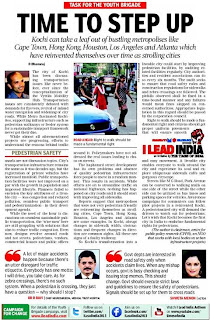Cochin is a fast developing commercial and tourist destination. But the city has its own problems – traffic jams, garbage strewn over the place, open drains, potholes, narrow roads and so on. What is it that can be done to make it a much better place to live? This is exactly what CPPR wishes to find out under Reinventing Cochin project….the part played by the state and civil society
Sunday, September 15, 2013
Broken road drained fuel tanks, burnt hole in pockets, says study
The approximate loss incurred by thousands of motorists and commuters who used an ill-maintained road has been quantified by a city-based NGO.
Through its project ‘Taking X-Rays of Roads’, Centre for Public Policy Research undertook a detailed study of the the Palarivattom-Kakkanad Road — a major road corridor that connects the city with the Collectorate.
Global Positioning System and Android applications were used to study parameters such as fuel wastage, its cost, subsequent increase in pollution and loss of man hours, said sources in the agency.
Loss incurred by way of fuel wastage, wear and tear of vehicles, increase in commuting time and rise in traffic snarls/accidents has also been quantified.
The Public Works Department had awarded a contract of Rs.10 crore to resurface the Palarivattom-Kakkanad Road. However, the contractor abandoned the work. The PWD’s ineptitude in speeding up the work meant road users’ pockets were further dented.
The survey found that the average speed of vehicles in the stretch fell to 19 km per hour from 30 km per hour. This speed is considered “very uneconomical” as per international standards (AASHTO Road Standards).
‘Forced stops’ due to presence potholes and rough road surfaces on the stretch increased fuel consumption of vehicles, especially of heavy vehicles like buses. Thus, expenditure on fuel by vehicles covering the stretch worked out to Rs.5,87, 672 per day as against the approximately Rs.2,72, 000 prior to the commencement of road repairs.
According to the study, fuel consumption increases by 50 per cent to 100 per cent when vehicles drive down potholed or ill-maintained roads. Since more than 95 per cent of cars were fitted with ACs, fuel consumption increased further by 10 per cent to 15 per cent.
This led to increase in pollution levels and added to the total loss to the economy.
Other factors such as maintenance cost for wheel alignment and tyre puncture further increased the financial burden on commuters.
Rise in pollution
Motoring down the road also increased the emission of noxious gases from vehicles. It is well known that halving of speed increases the emission of Carbon Monoxide (CO) by over 25 per cent.
Cost per person
The study also found that the total loss in time for a commuter who crossed the stretch was 20 minutes. This later increased from 25 minutes to 45 minutes.
Considering that the average daily wage in Kochi is Rs.500, the cost of total man hours lost worked out to Rs.60,000 per day.
Sunday, September 1, 2013
Parking woes to get worse
Kochi: With the Metro rail work gathering momentum and work along MG Road all set to start soon, parking problems will worsen in the city. Motorists will have a tough time ahead as the Metro authorities plan a total ban on parking along MG Road.
No agency, including the corporation, traffic police or the district administration has any idea about alternative arrangements for parking. Though the Kochi Metro Rail Limited expressed interest in renovating the Subhash Bose Park by providing parking space facility at its northern end, the proposal didn’t find favour with the corporation. The KMRL authorities are yet to submit a formal proposal, but the local body is against the concept of providing parking facility within the park.
“We will not allow any part of the Subhash Bose Park to be converted into a parking area. The city has only 0.3 per cent of open space, while urban planning norms stipulate 10 to 15 per cent of open space. So, no parking can be allowed in the park which is one of the few open spaces in the city”, said K.J Sohan, corporation Town Planning Committee Chairman.
Meanwhile, sources at the KMRL said they have no plans to change the existing structure and had only made a suggestion to revamp the park. The plan was to replace the damaged equipment, make a turf and to provide proper lighting.
According to urban planners, unless coordinated efforts are made, the only way out for people is to walk along the road after parking their vehicles at places far from their venues of interest, till the metro work gets over. “The number of people coming to MG Road will fall when the metro work starts.
However, proper parking facilities have to be provided near Vyttila mobility hub and other vacant spaces near the highway. If hop on-hop off buses are introduced to connect parking areas to MG Road and other city centres, the issue can be resolved to a certain extent”, said D.Dhanuraj, Chairman of the Centre for Public Policy Research, a city-based think-tank which conducted several studies on parking.
Subscribe to:
Posts (Atom)
